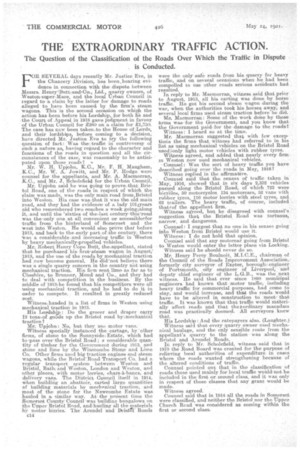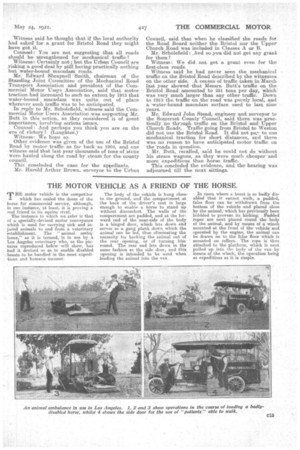THE EXTRAORDINARY TRAFFIC ACTION.
Page 10

Page 11

If you've noticed an error in this article please click here to report it so we can fix it.
The Question of the Classification of the Roads Over Which the Traffic in Dispute . is Conducted.
FOR SEVERAL days recently Mr. Justice Eve, in the Chancery Division, has been,hearing eve deuce in connection with the dispute between Messrs. Henry?Butt:and4Co., Ltd., quarry owners, of Weston-super-Mare, and the local Urban Council in iegard to• a claim by the latter for damage to roads alleged to have been caused, by the firm's steam wagons. This isthe second occasion on which the action has been. before his Lordship, for both he and the Court of Appeal in 1918 gave judgment in favour of the Urban Council for 2280 on a claim for £1,750. The case has now been taken-to the House of Lords, and their lardihips, before corning to a decision, have directed Mr. Justice Eve to try the following question of fact: Was theetraffic in controversy of such a nature as having regard to the character and functions of the roads in question and all the circumstances of the case, was reasonably to be anticipated upon those roads? .
Mr. W. H. Upjohn, K.O., Mr. F. H. Maugham, K,C., Mr. W. A. Jowitt, and Mr. P. Hodge were counsel for the appellants and Mr. A. Msemorran, K:C., and Mr. J. Scholefie4 for the Urban Council.
Mr. Upjohn said he was going to prove,that Brie: tol Road, one of the roads in respect of which the claim was made, was the only main road from,Bristol into Weston. His ease wastliat it was the old main road, and they had the evidence of a lady 1.014years old who remembered two eottehes a week goingialon.g it, and until the 'sixties of the.last centurythis`road was the .only one at all convenient or a,ceessiblotfor traffic from the hinterland of Somerset and the west into Weston. He would also preve that before 1913, and back to the.early part of.the center r, there Was a considerable and increasing traffic in Weston by heavy meehanieally-propelled vehicles. Mr. Robert Henry Cope Britt, the:appellant, stated that he purchased: his. first' steamwagon in August,' 1913, and the use of the roads by mechanical traction had now become general. He cliciSnot believe there was a single quarry concern in the country not using xneehanical traction. His firm sent lime as far as to Cheshire, to Brunner, Mond and Co., and they had to deal with competition in the business. By the middle of 1913.he found that his competitors were all using mechanical traction, and he had to do it in order to compete. It resulted in greatly reduced oost.
Witness,handed in a list of firms in Weston using mechanical traction in 1913.
His Lordship : De the grocer and draper ca.rSy 12 tons-of goods up the Bristol road lay-,mechanical traction?
Mr: Upjohn: Nce but they use motor vans.
Witness specially instanced the cartage, by 'other firms, of stone to the Sunnyside: Estate, which had to-pass over-the Bristol Road; a considerable quantity of timber for the Government during 1913. and stone and lime by the Winseombe Stone and Lime Co. Other firms used big traction engines and steam wagons, while the BristolS.Read Transport Co. had a. regular transport system between Weston and Bristol, Bath: and Weston, London and Weston, and other places, with motor lorries, chars-a-bancs. and deli-Very vans. The District Council itself in 1914, When building an abattoir, carted arge quantities of building materials by mechanical traction, and most of the stone for the Newcombe Estate was hauled in a similar way. At the present time the Somerset County Council was buildinr bungalows on the 'Upper Bristol Road, an dlianling all the gi aerials by motor lOrries. The Arundel and Dristol Roads
014
were the only safe roads from his quarry for heavy traffic, and on several occasions when he had been compelled to use other roads serious accidents had resulted.
In reply to Mr. Maernorran, witness said that prior to August, 1913, all his carting was done by horse traffic. He got his second steam wagon during the war, when the authorities took his horses away, and several local firins used steam traction before he did.
Mr. Ma,cmorran: Some of the work done by those hrms was for the Government, and you know that the Government paidfor the damage to the reads?
Witness: I be BO at the time.
Mr. Ma,cmorran suggested that with few exceptions the firms that, witness had referred to in his list as using mechanical vehicles.' onthe Bristol Road usedSonly light motor vehicles with rubber. tyres.
Witness agreed, and added that nearly every firm in Weston now used mechanical vehicles.
Counsel: Was the sort of heavy traffic you have described going over the roads in May, 1916? Witness replied in the affirmative. Counsel said that the census of traffic taken in May, 1916, showed that in six days 2,332 vehicles passed along the Bristol Road, of which 723 were bicyCles, 50 motorcycles, 134 motorcars 52 vans with rubber tyres, 116 motor lorries with steel tyres, and 62 trailers. The heavy traffic, of course, included thatsof the appellant firm.
Witness agreed, but he disagreed with counsel's suggestion that the Bristol Road was tortuous, narrow, and dangerous.
Counsel I suggest that no one in his senses going into Weston from Bristol would use it.
Witness: I do not hold that opinion. Counsel said that any motorcai going fromBristol to Weston would enter the latter place via Locking. Witness said he should never do so.
Mr. Henry Percy BoulnoiS, M.I.C.E., chairman oF the Council of the Roads Improvement Association,' formerly city surveyor of Exeter, borough, engineer of Portsmouth, city engineer of Liverpool, and deputy chief engineer of the L.G.B., was the next witness. He said that ever since 1898 municipal engineers had known that motor traffic,including heavy traffic for commercial purposes, had come to stay, and would increase, and that the roads would have to be altered in construction to meetthat traffic. It was known that that traffic would materially affect roads and that thesordinary macada,m road was practically doomed. All surveyors knew that.
His Lordship : And the ratepayers also. (Laughter.)
Witness said that every quarry owner used mechanical haulage, arid the only sensible route from the appellant's quarry to the station was along the Bristol and Arundel Roads.
In reply to Mr. Seholefield, witness said that in 191-0 the Road Board was created for the purpose of relieving local authorities of expenditure in cases where the roads wanted strengthening because of the altered conditions of traffic.
Counsel pointed out that in the classification of roads those used mainly for local traffic would not be included in the first or second class, and it was only in respect of those classes that any grant would be made Witness agreed.
Counsel said that in 1914 all the roads in Somerset were classified, and neither the Bristol nor the Upper Church Road was considered as coming within the first or second class.
Witness said he thought that if the local authority had asked for a grant for Bristol Road they might have got it.
Counsel: You are not suggestingthat all roads should be strengthened for mechanical traffic? Witness: Certainty not ; but the Urban Connell are risking a good deal by still having practically nothing but...water-bound macadam roads.
Mr.Shrapnell Smith, chairman of the Standng Joint Committee of the Mechanical Road Transport Association and president of the Coinrnercial Motor Users Association, said that motor traction had increased to such an extent by 1913 that water-bound macadam was quite out of place wherever such traffic was to be anticipated.
In reply to Mr. Schcoleheld, witness said the Commercial Motor•Users Association was supporting Mr. Butt in this action, as they considered it of great importance, involving serious issues. Counsel: And perhaps you think you are on the eve of victory (Laughter.) Witness; We hope so. Other. evidence was given of the use of the Bristol Road by motor traffic. as far back as 1904, and one witness said that last year thousands of tons of stone were hauled along the road by steam for the county council.
This concluded the case for the appellants. Mr. Harold Arthur Brown, surveyor to the Urban Council, said that when he classified the roads for the Road Board neither the Bristol nor the Upper Church Read was included in Classes A or B.
Mr. Scholefield: And so you did not get any grant for them?
Witness: We did _not get a grant even for the first-class roads.
Witness said he had never seen the mechanical traffic on the Bristol Road described by the witnesses On the other side.. A census of traffic taken in March last year showed that Messrs. Butt's traffic on the Bristol Road amounted to 2.:51 tons per day, which. was very much larger than any other traffic. DEWY!, to lai3 the traffic on the road was purely local, and a -water-bouncl macadam surface used to last. nine years.
Mr. Edward John Stead, engineer and surveyor to the Somerset County Council, said there was practically no thraugh traffic on the Bristol and Upper Church Roads. Traffic going from BriStol to Weston did not use the Bristol Road. It did not pay to use mechanical traction for short distances, and there was no reason to have anticipated motor traffic on the 'roads in question.
Mr. Butt, recalled, said he could not do without his steam wagons, as they were much cheaper • and more expeditious than horse traffic. This concluded the evidence, and the hearing was adjourned till the next sittings.
































